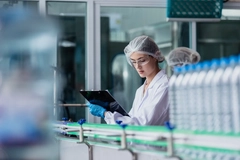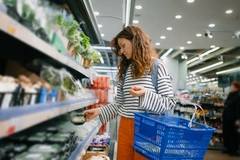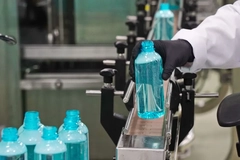WWF sustainable materials specialist: Beware plastic replacements and prioritize reuse
30 Nov 2021 --- Replacing plastic with alternative packaging materials is not the answer to pollution and may even worsen industry’s environmental impact, warns WWF’s sustainable materials specialist Paula Chin. Instead, a systems-based approach focusing on reuse and refill models must be implemented in which policymakers and businesses are held fully accountable.
Chin speaks with PackagingInsights ahead of tomorrow’s opening of Packaging Innovations in London, UK, which will see a host of experts discuss the packaging industry’s role in the climate and pollution crises.
The materials specialist explains that while the war on single-use items is necessary, misperceptions about the role of plastics abound. She asserts the public must shift their attention to wider concerns over the full life cycle of packaging materials. “It’s not: ‘all plastics are bad, and everything else is good,’” she emphasizes.
Chin will be presenting the findings of a new WWF study at the event, looking at both the environmental and social footprint associated with the UK’s packaging consumption. Here, she delves into the most salient findings and outlines how a perspectival shift is needed to drive the right kind of industry change.
Plastic demonization concerns
When we [the WWF] think of “environmental footprint,” says Chin, “we mean the impacts of material extraction, processing and production around the world before packaging is placed on the market.”
“As with many products sold in the UK, the activities required to get these products onto the UK market take place in other parts of the world, so it’s trying to raise awareness of what those impacts are, which parts of the world are most affected by them and how the different material supply chains can address those impacts.”
This globalized supply chain means the full life cycle of material must be considered both environmentally and socially, she argues.
 Industry and policymakers must focus on refill and reuse systems rather than new materials, insists Chin.“In recent years, industry has rightly been very focused on plastic pollution, but there’s been a lot of switching to different materials as businesses move away from plastics. In the long run, this could lead to worse environmental and social impacts as impacts shift to other supply chains.”
Industry and policymakers must focus on refill and reuse systems rather than new materials, insists Chin.“In recent years, industry has rightly been very focused on plastic pollution, but there’s been a lot of switching to different materials as businesses move away from plastics. In the long run, this could lead to worse environmental and social impacts as impacts shift to other supply chains.”
She stresses the report supports collective action to reduce the overall consumption of virgin materials by eliminating the need for packaging completely or mainstreaming reuse and refill systems. For example, The Body Shop continues to expand its in-store refill program.
Systems thinking approach
Chin says she hopes there will be more evidence of systems thinking at Packaging Innovations this year, especially in relation to reuse and refill. Systems thinking is a holistic way to investigate factors and interactions that could contribute to a possible outcome.
“Single-use packaging is still a short-term use of resources, regardless of the material. The embedded impacts associated with the sourcing of those materials contribute to climate change and biodiversity loss, so we need to use them more efficiently and consider them more precious.”
“I’m also hoping for evidence the industry is considering packaging use within an overarching framework of net-zero requirements and reversing biodiversity loss, and not just pursuing plastic-focused solutions nor recycling as the answer to both those crises.”
Addressing pollution the right way
Plastic pollution is one of the most visible symptoms of the environmental crisis we’re facing, notes Chin. “We’re nowhere near addressing the problem in a meaningful way.”
The UK government must ensure producers take full responsibility for the waste from the products they sell by introducing a comprehensive deposit return scheme and ensuring consistent recycling collections from homes and businesses, she says.
“Also, the recently announced consultation on banning additional single-use plastic items, namely plates, cutlery and balloon sticks, is a welcome step but more needs to be done,” adds Chin.
Those items amount to 14,000 tons of plastic, compared with the estimated 5 million tons of plastic placed on the UK market each year – it’s “literally a drop in the ocean,” Waste management infrastructure is more important than reducing certain material types, Chin asserts. she highlights.
Waste management infrastructure is more important than reducing certain material types, Chin asserts. she highlights.
“We need to prioritize tackling our single-use culture overall by incentivizing a shift to reusable, refillable alternatives. While many businesses are already running their own initiatives to support consumers to experience reuse and refill systems, it’s a very piecemeal approach driven by individual businesses.”
Misguided anti-plastic sentiment
Chin asserts the idea that eradicating plastic pollution would be a panacea for environmental issues is a misguided one. “Plastic was invented to avert an impending ecological disaster, replacing the use of elephant ivory for billiard balls in the 1800s. Similarly, the plastic bag was intended to be reusable when it was invented in 1962,” she points out.
Although plastic is an inherently versatile, affordable material enabling modern lifestyles, communities worldwide are now faced with the problem of what to do with growing pollution issues.
Plastic production is set to increase by 40% by 2030, and plastic products have become increasingly complex, so it’s impossible to recover it all, Chin continues. “It can’t start and end with addressing plastic pollution – there are impacts throughout the plastics supply chain.” A recent WWF report calculated that if plastics were a country, it would be the fifth-largest emitter globally.
“To address this crisis, we need to turn off the plastic tap. Doing that will mean finding ways to increase resource efficiency and minimize waste, for example, through reuse, refill or repair systems and business models,” she says.
“I don’t expect to see a world where we no longer use plastics, nor is this necessarily the best outcome.” Chin points to Green Alliance’s 2020 Fixing the System report, which showed switching all current consumption of UK plastic packaging (1.6 million metric tons) on a like-for-like basis to the other materials could almost triple carbon emissions.
“We need to be mindful of this when substituting plastics for other more carbon-intensive materials,” she warns.  Illegal waste trafficking is the result of poorly designed packaging and a lack of waste infrastructure.
Illegal waste trafficking is the result of poorly designed packaging and a lack of waste infrastructure.
Who is to blame?
Chin says both industry and government have significant roles to play in addressing this issue.
Upstream product development decisions by businesses ultimately have a material impact on downstream waste management efficiencies, not least when it comes to selling products into markets, with inadequate waste management systems that can’t deal effectively with certain types of complex waste streams such as plastics, she explains.
Failure to produce high-quality packaging is also at the root of the multi-billion dollar illegal waste trafficking industry, seeing poorer nations routinely absorbing polluting materials en masse.
There is also a continued lack of investment into the waste system by governments, businesses and financial institutions – policy mechanisms, such as extended producer responsibility schemes, which adopt the better known “polluter pays” principle, are one way to raise revenues for necessary waste infrastructure, she says.
Combatting single-use culture
Businesses and their investors often seek out technological solutions to a problem, adds Chin. “In this case, switching from single-use plastics to another single-use material is not the answer.”
“All materials have both environmental and social impacts throughout their supply chains. We must tackle the single-use culture overall by incentivizing a shift to reusable, refillable alternatives.”
“We can’t afford to ignore lessons from the past,” she continues. “The invention of plastics to replace ivory for billiard balls and then the ‘reusable’ plastic bag to replace paper – this simply shifts the problem. We need to tackle our dependency on single-use overall.”
“Businesses need to move from a narrow focus on recycling, especially when it comes to plastics and make progress on the harder task of moving to more resource-efficient business models, such as reusable and refillable packaging,” she concludes.
By Louis Gore-Langton












